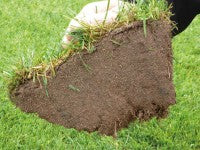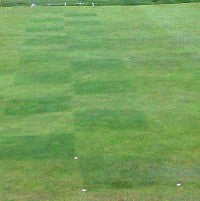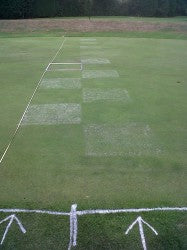Granular fertilisers - the inside story!
 The granules in granular fertiliser contain four major component groups: the carrier substrate, the nutrients, additional beneficial materials and surface dressings or coatings.
The granules in granular fertiliser contain four major component groups: the carrier substrate, the nutrients, additional beneficial materials and surface dressings or coatings.
The carrier substrate forms the spherical structure of the granule and binds together the active ingredients. This is a cementing compound that has ball-forming and setting capability. All ingredients of the fertiliser are accurately weighed in the required proportions and thoroughly mixed with water solvent.
The balling is achieved by rolling and falling actions on the damp slurry mixture of carrier and active ingredients. After the balling, heating is required to set the cementing compound and stabilise the spherical structure. Surface coating materials may be added after granulation to add further components, to prevent caking of the granules or apply a semi-permeable membrane to give slow release properties.
Granules are then graded to size fractions, with those between 0.5mm and 2mm taken for fine turf fertiliser use. Many fertilisers are blended post granulation to achieve the required nutrient characteristics, but homogeneous granules give more even spread of nutrients on fine turf at low application rates with minimum risk of speckling, so are generally preferred.
 We will consider now the many nutrient components that are proportionally incorporated to achieve the required balance and nutrient release pattern.
We will consider now the many nutrient components that are proportionally incorporated to achieve the required balance and nutrient release pattern.
Nutrient content is conventionally expressed as percentage, e.g. 5% N, 2% P2O5, 12% K2O, 2% MgO and possibly also SO3, CaO, Fe, Mn, Cu, Zn, B, Mo, Cl, Si, and maybe more! Organic compounds may contain tens or hundreds of beneficial components that are not declared on the analysis. Phosphorus, potassium, magnesium, calcium and sulphur are expressed in the UK as their oxide form but, in most of Europe, the elemental forms are expressed. Take care with this; you may not be applying the right dose if you are misled - simple to use conversion tables are available.
Nitrogen is derived from animal and plant proteins in organic fertilisers. Most of these nitrogen sources require breakdown and solubilisation (mineralisation) by soil microbes to permit uptake by plants. Most organic fertilisers have slow-release properties. In mineral fertilisers, nitrogen is generated from ammonia produced by the Haber process that is reacted atmospheric nitrogen with hydrogen.
Many types of nitrogen fertiliser are derived from ammonia. Soluble and rapidly available nitrogen fertilisers that are often used in granular turf fertilisers include ammonium sulphate, ammonium nitrate, urea, potassium nitrate and mono ammonium phosphate.
 Many synthetic, slow-release nitrogen fertilisers are included in granules, e.g. methylene urea, and Isobutylidenediurea. These require solubilisation by microbes or hydrolysis prior to uptake. Their release characteristics can be influenced by microbes included in the granules, so this must be considered in the overall ingredient mix.
Many synthetic, slow-release nitrogen fertilisers are included in granules, e.g. methylene urea, and Isobutylidenediurea. These require solubilisation by microbes or hydrolysis prior to uptake. Their release characteristics can be influenced by microbes included in the granules, so this must be considered in the overall ingredient mix.
Organic phosphate is a major component of bone meal, and is also available from plant tissue. Rock phosphate is the mineral source of phosphate.
Superphosphate, mono ammonium phosphate and potassium phosphate are soluble phosphate compounds prepared from insoluble rock phosphate.
Supplies of rock phosphate are limited and share demand with the detergent industry. Phosphate recovery plants are being set in place now at sewage works to make a clean (odour free) and safe slow-release form of magnesium-ammonium-phosphate that can be incorporated into granular turf fertilisers.
Organic potassium is available from plant and animal material, including potassium humate, the end product of organic decomposition. Mineral potassium fertilisers are widely available from seawater and evaporite deposits worldwide. Mineral potash fertilisers used in granulated turf fertilisers include potassium sulphate, potassium chloride, potassium nitrate and potassium phosphate.
Organic magnesium fertiliser is made from processed animal, fish and plant material. Mineral magnesium sources are the same as potassium sources above. Magnesium sulphate is the main inorganic Mg source in granular fertilisers. Magnesium carbonate may also provide some slow release magnesium in some compounds.
Sulphur occurs in organic animal and plant compounds and animal manures. Inorganic sulphate is provided from potassium sulphate, magnesium sulphate, ammonium sulphate and iron sulphate.
There are many trace elements that play essential roles in turf metabolism and synthesis of complex protein compounds. Over sixty elements have been identified in organic compounds with varied proven benefit.
This organic trace element provision is much wider than the six to eight trace elements with proven benefit that are added from mineral sources. Metallic trace elements, e.g. Fe and Mn, may be made unavailable in soils with higher pH and may fix to ion exchange sites on clay particles. Chelating organic compounds aid their availability; these include humic and fulvic acids, both from natural organic breakdown and added with fertilisers, lignosulphonates and synthetic chelating acids, such as EDTA. Organic compounds in fertilisers have a huge effect on the provision and availability of trace elements in the soil.
Organic and mineral biostimulants can be incorporated into turf fertilisers. Organic beneficial materials include non-living and living materials. Humic acids, lignosulphonates, amino acids, gibberellins, chitin, oligosaccerides and a long list of other complex compounds form the non-living group.
These materials have two main benefits to turf; they provide food for beneficial organisms in the turf and have an elicitor effect on turf metabolic functions. The living microorganisms are fungi, bacteria and archaea that are introduced into the thatch layer and rootzone to enhance natural degradation and protective functions.
The available beneficial microbes are many; this is a taste of some that are in use now. Trichoderma species digest root pathogens and thatch material. Bacillus species supress pathogens around turf roots and re-cycle organic exudates within the soil, so solubilising useful nutrients. Nitrogen fixing bacteria can be introduced that take N from the atmosphere and transform it into available nitrate to support growth. Mycorrhizal symbiotic fungi associate with roots, and aid the capture of water and nutrients, especially of locked up phosphate.
 Complex mineral-organic fertilisers, such as Vitax Enhance, have been recently developed to bring most of these benefits together in each single mini-granule. There is a lot going on inside.
Complex mineral-organic fertilisers, such as Vitax Enhance, have been recently developed to bring most of these benefits together in each single mini-granule. There is a lot going on inside.
Bill Riley BSc Hons is Technical Manager for Vitax Ltd www.vitaxamenity.co.uk
